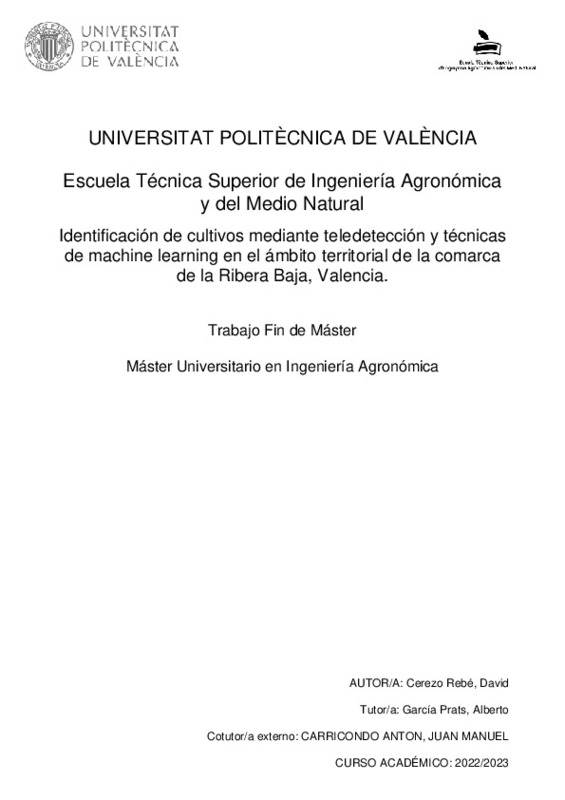|
Resumen:
|
[ES] La revolución tecnológica que está sufriendo la agricultura, conocida como Agricultura 4.0 o Agricultura de Precisión permite, no solo a los productores, sino también a las Administraciones responsables de la gestión ...[+]
[ES] La revolución tecnológica que está sufriendo la agricultura, conocida como Agricultura 4.0 o Agricultura de Precisión permite, no solo a los productores, sino también a las Administraciones responsables de la gestión de recursos públicos, tener un mayor conocimiento de la realidad que gestionan. Sin embargo, para que la tarea tenga éxito, el primer paso es disponer de cartografía fidedigna de las superficies realmente cultivadas, así como los cultivos establecidos para la estimación de la demanda real.
En este trabajo se plantea la aplicación de la teledetección junto con algoritmos de clasificación supervisada y no supervisada de machine learning (ML) con el objeto de identificar los cultivos establecidos en el ámbito territorial de la comarca de la Ribera Baja, Valencia. Como productos satelitales se recurrirá principalmente a la misión Sentinel-2 (sin descartar otras) por ser la que mayor resolución espacial ofrece (píxeles de 10 m de lado) entre las misiones de libre acceso. Sentinel consta de 2 satélites gemelos (Sentinel-2A y Sentinel-2B) que combinados ofrecen un período de revisión de imágenes de 5 días. Como variables explicativas se emplearán tanto las distintas bandas de reflectancia como los principales índices espectrales de vegetación: NDVI, LAI, EVI, SAVI, NDWI, etc.
Respecto de las técnicas de clasificación de ML se explorarán distintos algoritmos programados en Phyton 3.x. adoptando aquellos que muestren mejor comportamiento en base a las métricas habituales (accuracy, confusion matrix, precision, recall, F1 score, AUROC). En la literatura más reciente, algoritmos como random forest (RF), support vector machine (SVM) o las redes neuronales recurrentes (CNN) aparecen como los métodos más prometedores. La verdad terreno se obtendrá de SIGPAC y la ortofoto más reciente sobre la que se generará un conjunto de parcelas de contraste por fotointerpretación.
[-]
[EN] The technological revolution that agriculture is undergoing, known as Agriculture 4.0 or Precision Agriculture, allows not only producers, but also the Administrations responsible for the management of public resources, ...[+]
[EN] The technological revolution that agriculture is undergoing, known as Agriculture 4.0 or Precision Agriculture, allows not only producers, but also the Administrations responsible for the management of public resources, to have greater knowledge of the reality they manage. However, for the task to be successful, the first step is to have reliable cartography of the areas actually cultivated, as well as the crops established for estimating real demand.
This work proposes the application of remote sensing together with supervised and unsupervised classification algorithms of machine learning (ML) in order to identify the crops established in the territorial area of ¿¿the Ribera Baja region, Valencia. As satellite products, the Sentinel-2 mission will be used mainly (without ruling out others) as it is the one that offers the highest spatial resolution (pixels measuring 10 m on each side) among the freely accessible missions. Sentinel consists of 2 twin satellites (Sentinel-2A and Sentinel-2B) that combined offer a 5-day image review period. Both the different reflectance bands and the main vegetation spectral indices will be used as explanatory variables: NDVI, LAI, EVI, SAVI, NDWI, etc.
Regarding ML classification techniques, different algorithms programmed in Python 3.x will be explored. adopting those that show the best performance based on the usual metrics (accuracy, confusion matrix, precision, recall, F1 score, AUROC). In the most recent literature, algorithms such as random forest (RF), support vector machine (SVM) or recurrent neural networks (CNN) appear as the most promising methods. The ground truth will be obtained from SIGPAC and the most recent orthophoto on which a set of contrast plots will be generated by photointerpretation.
[-]
|








